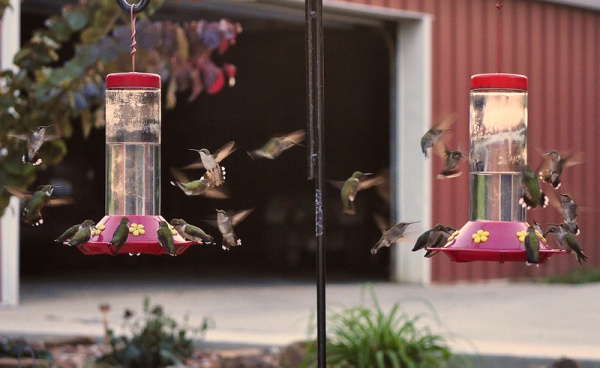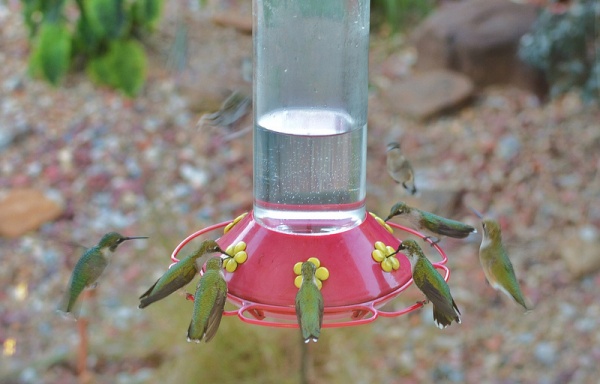
Last week Peter Bell alerted me to this awesome photo of more than two dozen ruby-throated hummingbirds. Taken on September 18 by Illinois photographer jeffreyw, the feeders are mobbed by tiny birds. Jeffrey aptly calls this, “Please take a number.”
If you feed hummingbirds, I’m sure you find this scene as amazing as I do. Normally a single hummer dominates the feeder and chases all others away. Who knew that when large numbers feed together they line up peacefully!
See how nicely they’re behaving?

And here’s a quick video of Jeffrey’s feeders in mid-August. You can hear them chirping. Wow!
I asked Jeffrey how he attracts so many hummingbirds.
He wrote, “We mount feeders according to demand, one early [in the season], then adding until we get to 5 feeders. We could add more but have restricted ourselves lest the project gets out of hand. As the birds migrate away we remove feeders until we are back to one and leave that one till the freeze.
We have been building our flock for 25+ years.”
Persistence pays off. Feed them (a lot!) year after year, and they will come.
Thanks to JeffreyW for permission to use his photos. Hummingbirds aren’t his only subject. Check out his photos and food on the What’s 4 Dinner Solutions blog.
(photos and video by jeffreyw)
p.s. Very soon all the ruby-throats will have left the eastern U.S. for their winter home. If you’re addicted to hummingbirds and up for a challenge, leave your feeder out, keep it from freezing, and you just might attract a Selasphorus (rufous or Allen’s) hummingbird newly arrived from western North America. Here’s Scott Weidensaul’s advice on how to attract these unusual western hummingbirds and Rob Protz’ history of rufous hummers in Pennsylvania.
I am also fortunate to have so many hummers and I do the exact same thing he does. Start out with one feeder in the spring and I normally go to 4 feeders 2 of them hold 32 ounces and they drain all the feeders twice a day during what I consider the peak season July. I’ve been feeding them for about 16 years. I should keep track of how many 5lb bags of sugar I buy each summer.
“Who knew that when large numbers feed together they line up peacefully!”
Well they might willing sit next to each other at feeders buy it is anything but peaceful. LOL They constantly argue and argue and knock each other around. I look forward to their return next spring.
First of all, thanks for the link, Kate! 🙂
You really must plan a trip down to Gerry’s place in Montrose WV next summer. You can see the same thing in spades! Gerry normally uses about 25 feeders on her deck.
And Karen’s right about how it goes. They do feed together, but it’s constant bickering all the while! And I’m talking about at least 60 hummers at one time.
One more thing to note. . .
You can see it at the end of the video, but note in the second still pic above, there are 2 hummers feeding from the same port on the left side of the feeder! That’s how cooperative they can be in this situation. And actually, the more feeders there are, the better the cooperation.
Oh, and I count 23 hummers in the top picture above.
When do the ruby-throated hummers usually leave the area. I have kept my feeders up all spring and summer, and I’m surprised that there is still so much activity at each feeder. I’ve never been able to accomplish what Jeffrey has – there is always a “fight to the finish” for feeder position, even though I have 3 feeders. They were all relatively close in proximity to each other, but the “bully” would not let any of the others near the feeders, that’s when we decided to spread them out a little and at least all the others were able to get a little food. The males seemed to have disappeared in mid-summer, but returned a just last week.
I count 25….another thing I’ve noticed thru the years is if you have a male or female guarding a feeder – that means no one eats (or so they think) but them…..the later it gets into the evening all is forgiven and everyone gets to eat without being attacked.
Ooops. . . on recount I get 25 hummers in the top picture!
When I first counted I think I had 21…but by the end of the day I was up to 26. There are 13 on either side, and if I had to guess which one I’ve spotted, that isn’t in Rob’s count, I’d guess it’s on the far left. It’s easier to see if you click the photo then click the magnifying glass on the page that takes you to.
Kate-
Thanks for the nice write up! For the hummer counters out there here’s a pic from August with all five of my feeders in the frame, shot from our kitchen window: (1600×1060)
http://www.flickr.com/photos/jeffreyww/7782123524/sizes/h/in/photostream/
jeffreyw
P.S. I see 26 on the top photo, counting the one on the left feeder that is showing just the tips of its tail.
Good catch with the tail….I also count 26. I have a question. Let’s say I have 4 feeders out and try to do an estimated count….first count all the holes, how many are sharing, how many are flying around waiting and how many are sitting on branches. Let’s say you get 30….here’s my question. Now it’s a half an hour later and you count 25 hummers are they the same hummers or are there 40 different or 60 different or more birds that visit my feeders in a given day???? Does anyone know where they roost? Please excuse my questions but I haven’t had the chance to talk about amount of birds my feeders attract.
Well, now that jeffery noted the tail on the left feeder I’m upping my count to 27! To the left of the feeder there is an upper and a lower hummer waiting their turn. But the lower one is actually two if you ask me (two beaks and two tails when you view you larger photo!)
Yay! I see 27 too!
Peter- You are correct! I see the two you point out.
Karen- I’ve wondered about how to count a resident population and have come up blank with the means available to me. I believe that the local birds come repeatedly to the feeders throughout the day so a count at 2 o’clock will certainly recount birds from a 1 o’clock count. Perhaps marking a few birds would allow a rough calculation towards determining the feeding frequency of individuals, and from that one may arrive at a population estimate but those calculations are beyond my own abilities.
Yes I see 27 too! See how hard is to count them in a picture….it’s impossible to do it live but we try. Thanks Jeffrey for your feedback….I agree the calculations are beyond my abilities too! LOL
Referencing local population counts. . .
Bob Sargent (the hummer guru from Alabama) http://hummingbirdsplus.org/ has a rule: Take the maximum number of hummers in view you can count at any time and multiply by 5. That gives a rough estimate of the number in the area.
As to Jeffrey W’s comment about marking a few birds. . . Yes, that’s how it’s done, but as the saying goes, DON’T TRY THIS AT HOME! It’s illegal unless you’re a bander, and even the banders need special permission to mark the birds they band. They usually mark them on the forehead, but some do it on the back.
Wow Rob that’s amazing. No I would never attempt to band or mark a hummingbird. So this formula makes sense to me and doesn’t surprise me either. I figured that there were a lot of hummers around.